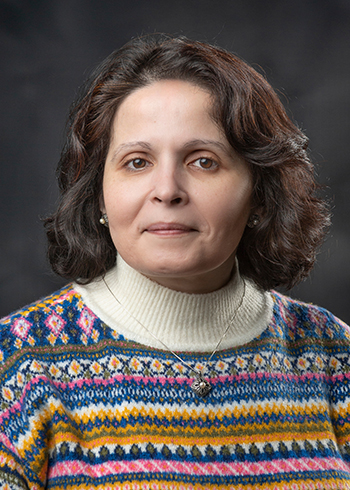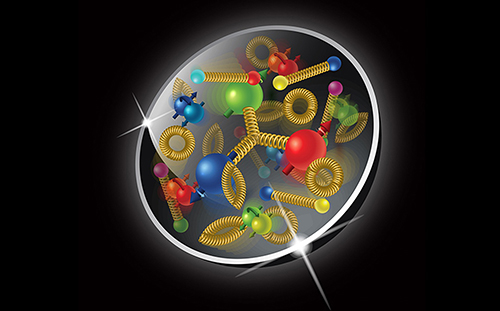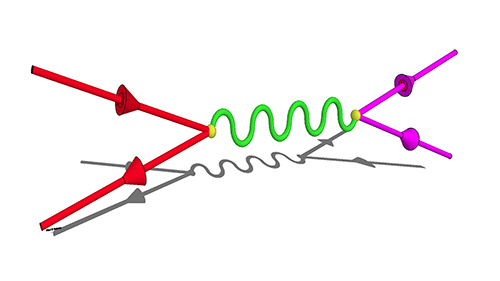MSU researchers’ findings featured in Nature article on proton ‘broken symmetry’
Contact: Sarah Nicholas
STARKVILLE, Miss.—A Mississippi State faculty member’s research on asymmetry in protons is introduced in today’s [Feb. 24] edition of Nature, a national publication featuring top-quality peer-reviewed research in all fields of science.
Along with their research collaborators, Associate Professor Lamiaa El Fassi of MSU’s Department of Physics and Astronomy and Catherine Ayuso, an MSU post-doctoral research associate, have written a paper on the study “The asymmetry of antimatter in the proton.” It focuses on how the proton, a positively charged particle that exists at the center of every atomic nucleus, displays “broken symmetry,” which describes an object that seems symmetric but isn’t.


To read about the research, visit
https://www.nature.com/articles/s41586-021-03282-z
Physicists at the U.S. Department of Energy’s Argonne National Laboratory and their collaborators at various U.S., Japan and Taiwan universities, recently investigated the intricacies of this known broken symmetry through an experiment conducted at DOE’s Fermi National Accelerator Laboratory. The results of the experiment could shift research of the proton by reviving previously discarded theories of its inner workings.
“Dr. El Fassi’s findings are yet another example of how MSU researchers contribute significantly to the body of science and make extraordinary discoveries—discoveries that are capable of changing the trajectory of the field or creating paradigm shifts,” said Giselle Thibaudeau, associate dean for research in MSU’s College of Arts and Sciences. “We are extremely proud of Dr. El Fassi and her collaborative team and look forward to their future successes in nuclear physics. In particular, we look forward to hearing more about the asymmetry in the proton, which until this recent discovery has been assumed to display symmetry.”

MSU Physics Department Head Mark Novotny said humans exhibit a bilateral symmetry, in that their left and right halves are identical. “Actually, this is broken symmetry,” Novotny explained, “in that their left and right sides are only approximately the same if they were reflected in a mirror. The paper in Nature of Drs. El-Fassi and Ayuso, as well as their collaborators, studied broken symmetry of the proton. Understanding the proton is important because we are, by mass, about one-half protons. Science advances by constantly advancing theories and checking those theories through experimentation in order to understand nature, and then utilizing that understanding in applications.”
El Fassi began the long-term project as a postdoctoral fellow at Rutgers University and continued her research when she joined MSU’s faculty as an experimental nuclear physicist in 2014.
“This study is intriguing because it aims to unravel the dynamics of the evanescent low-momentum pairs of quark and anti-quark—the antiparticle counterpart of each quark flavor with similar mass but opposite electric charge—in the sea of the proton by studying the asymmetry of two anti-quark flavors, anti-up and anti-down quarks, in terms of their momentum fractions,” El Fassi said.

She explained that the current research conclusions oppose the 1990s experimental results that originally indicated anti-up quark dominance over anti-down quark at higher momentum fractions. El Fassi’s research also revives older theoretical models which did not support the 1990s conclusions but “perfectly agree” with the current scenario.
“This is just the beginning of the sea quarks investigations journey because Catherine Ayuso and I are pursuing a study probing the correlation between the antiquark’s orbital angular motion and the proton spin—an intrinsic quantum property describing the internal revolution about its axis of symmetry—in the SeaQuest successor experiment, the ‘SpinQuest experiment.’”
El Fassi’s work is supported in part by MSU’s College of Arts and Sciences and university start-up funds as well as the Department of Energy’s Office of Nuclear Physics award.
El Fassi received her Ph.D. in 2008 from Mohammad V University in Rabat Morocco jointly with Argonne National Laboratory in Lemont, Illinois. Ayuso earned her Ph.D. from Michigan University in 2020. Her doctoral research with SeaQuest involved analyzing the experimental data of this research project. She is working at MSU with El Fassi for a three-year postdoctoral fellowship.
MSU’s College of Arts and Sciences includes more than 5,000 students, 323 full-time faculty members, nine doctoral programs, 14 master’s programs, and 27 undergraduate academic majors offered in 14 departments. MSU is classified by the Carnegie Classification of Institutions of Higher Education as a “Very High Research Activity” doctoral university. Complete details about the College of Arts and Sciences or the physics department may be found at www.cas.msstate.edu or www.physics.msstate.edu.
MSU is Mississippi’s leading university, available online at www.msstate.edu.